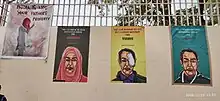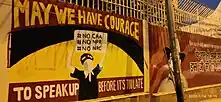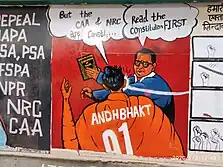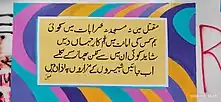
Students and artists created art and graphite paintings on the walls and roads of the Jamia Millia Islamia campus in New Delhi, India, following the 2019 Jamia Millia Islamia attack by Delhi Police in December 2019.[1] The protest art also spread into the neighborhood of Shaheen Bagh and their protests,[2][3] and continued to be created into January and February 2020.[4][5][6]
In addition to visual art, protesters also utilized literature, theatre, and music.[6] The protest art, and protests as a whole, were also characterized by the widespread mobilization of women and women artists.[6]

Background
On Friday, 13 December, 2019 Delhi police had a lathi charge on the students who agitated against the Citizenship Amendment Act bill. This violent attack by the police sparked agitation among the students.[7][8]
Graffiti and murals
On the day of the attack, 13 December, a post-graduate student of Fine Arts first started painting on the walls to show her resistance against the police action on students. Other artist and students followed suit later, with both graffiti and murals.[9][10]

After the 15 December incident, the image and video of a group of female students wearing hijabs standing up to Delhi police went viral.[11] This visual, of a student wearing a hijab pointing at the police, demanding that they stop beating students, became the basis of art and symbolic expression of this protest.[3]
Students called for art, and artists responded, with the walls of the campus from the stadium to Gate No. 4 becoming covered with graffiti.
Grafitti was also added to roads in and around the university's campus.[12] The road art included caricatures of Prime Minister Narendra Modi, Minister of Home Affairs Amit Shah, alongside slogans such as "You can't impose 144, on our speech, freedom and truth," "Jiyo aur jeene do" (live and let live), "#No CAA, #No NRC," and "Mera desh, mera samvidhan" (My country, my constitution).[12] Other slogans, such as "Zinda Qaume Panch Saal Tak Intazar Nahi Karti'," further expressed anti-dictatorship and anti-authoritarian sentiments.[13]

Other individuals portrayed in the protest art included Bhagat Singh, Mahatma Gandhi, Dr. B.R Ambedkar, Jawaharlal Nehru, Maulana Abul Kalam Azad, Mohammad Ali Jauhar and Dr Zakir Hussain.[14]
Many of the artists shared their art anonymously or under pseudonyms, out of fears for their safety.[3]
Removal of graffiti
In March 2023, When the Delhi government announced a complete lockdown as a precautionary measure to prevent the spread of coronavirus, the students called off the protest on March 21.[15] Considering this as a profitable opportunity, Delhi Police began removing the graffiti on the campus of Jamia Millia Islamia and in Shaheen Bagh.[16][15]
Literature

During this 100 day long protest, resistance literature has been the flag of the agitation. Specially Faiz Ahmad Faiz's 'Hum Dekhenge' and Habib Jalib's 'Dastoor'. With immense energy and emotions, these nazm soon became the title of the protest. 71st Republic Day was being celebrated by the protesters with all these nazm.[17] During this protest, Rahat Indori's couplet also became the voice of the common people.
“Sabhi ka khoon hai shaamil yahaan ki mitti me
Kisi k baap ka Hindustan thodi hai.”
This is one of the famous lines that can be seen on the protest site.[18] Avtar Singh Pash and Dushyant Kumar's famous resistance poetry were also painted on the wall of Jamia.
Songs
Songs are always the bearer of protest and play a role in spreading the conscience about the issue among the common man. It is generally situational and associated with the cause and movements.[19] In this agitation, many poets and musician came out as their own version of resistance songs. Few became very popular and famous among the people like 'Hum Kagaz Nahi Dikhayenge' by Varun Grover and Sab Yaad Rakha Jayega by Amir Aziz.[17]
See also
References
- ↑ Sampath, G. (2019-12-20). "Thousands of students march in solidarity with JMI and AMU students, and to oppose CAA". The Hindu. ISSN 0971-751X. Retrieved 2023-11-27.
- ↑ Singh, Gayeti. "Meet the artists resisting India's new citizenship law". Al Jazeera. Retrieved 2023-11-27.
- 1 2 3 Agrawal, Soniya (2020-02-16). "Shaheen Bagh and the new wave of protest art that's sweeping across India". ThePrint. Retrieved 2023-11-27.
- ↑ Karki, Meghal (2023-05-12). "The changing cityscape of Delhi: A study of the protest art and the site at Jamia Millia Islamia and Shaheen Bagh". Educational Philosophy and Theory. 55 (6): 731–742. doi:10.1080/00131857.2022.2073221. ISSN 0013-1857.
- ↑ Patel, Shivam (2020-01-04). "Weeks after campus was stormed, Jamia is fighting back — with some street art". The Indian Express. Retrieved 2023-11-27.
- 1 2 3 Ara, Ismat (February 15, 2020). "'Walls Are the Publishers of the Poor': How Women Sketch the Language of Resistance". The Wire. Retrieved 2023-11-27.
- ↑ Ellis-Petersen, Hannah; correspondent, Hannah Ellis-Petersen South Asia (2019-12-13). "Violent clashes continue in India over new citizenship bill". The Guardian. ISSN 0261-3077. Retrieved 2023-11-27.
- ↑ Staff, Scroll (2019-12-13). "Jamia students baton-charged by Delhi Police during march to protest Citizenship Act, 50 detained". Scroll.in. Retrieved 2023-11-27.
- ↑ Nandy, Asmita (2020-02-22). "The Revolution Will be Painted: Jamia Resists With Graffiti". TheQuint. Retrieved 2023-11-27.
- ↑ Saraswati, Bhumika (2020-01-20). "How street art plays a role in the Jamia resistance". The Hindu. ISSN 0971-751X. Retrieved 2023-11-27.
- ↑ "The hijab-clad students who stood up to Delhi police". Reuters. 2019-12-18. Retrieved 2023-11-27.
- 1 2 Archana, KC (2020-01-03). "Art In The Time Of Protests: Jamia Students Are Now Painting Roads With Anti CAA & NRC Graffiti". IndiaTimes. Retrieved 2023-11-27.
- ↑ "In Photos: Students Fight Back During Jamia's Year of Rebellion". The Wire. Retrieved 2023-11-28.
- ↑ "Weeks after campus was stormed, Jamia is fighting back — with some street art". The Indian Express. 2020-01-04. Retrieved 2023-11-28.
- 1 2 Khan, Fatima (2020-03-24). "Art installations at Shaheen Bagh, Jamia removed by Delhi Police, graffiti painted white". ThePrint. Retrieved 2023-11-27.
- ↑ "Police Remove Jamia Graffiti, Twitter Reminds Them of 'Priorities'". TheQuint. 2020-03-24. Retrieved 2023-11-27.
- 1 2 "Poetry and songs have become the soul of the nation-wide protests against the new citizenship law". The Indian Express. 2020-01-12. Retrieved 2023-11-27.
- ↑ "'Walls Are the Publishers of the Poor': How Women Sketch the Language of Resistance". The Wire. Retrieved 2023-11-28.
- ↑ "To protest is to verbalize a dissatisfaction with the status quo," Elizabeth J. Kizer, "Protest Song Lyrics as Rhetoric," Popular Music and Society IX, No. 1 (1983): 3.